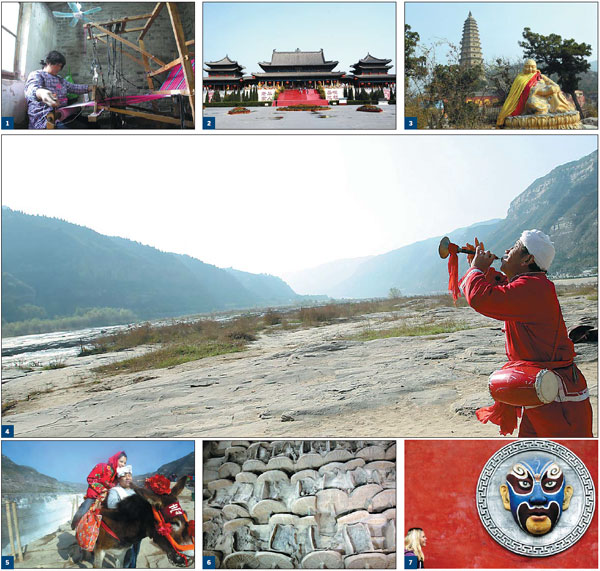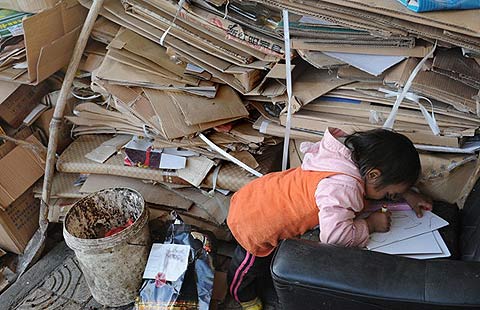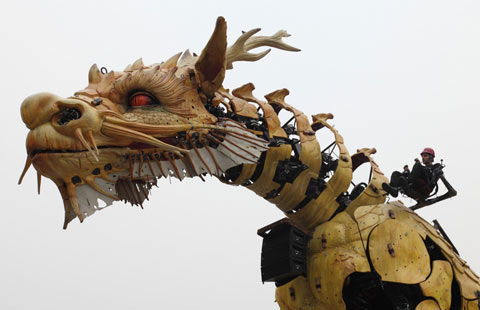Call to tourists from one ... of the birthplaces of China
Updated: 2014-11-29 06:43
By Yang Feiyue(China Daily)
|
|||||||||||
Linfen offers an array of sites for both nature and history buffs.
Being from China, I was a little ashamed that I didn't know Linfen was one of the birthplaces of the Chinese nation.
I recently took a three-day trip to Linfen. The city, located in southwestern Shanxi province, is about a five-hour high-speed train ride from Beijing. I arrived late in the afternoon and visited the Fen River Park, which was built along Fen River, the mother river of Shanxi.
|
1. A woman weaves bed sheets at Dingcun village. 2. Ancestor hall at the Giant Locust Tree. 3. Feihong Pagoda at the upper part of Guangsheng Temple. 4. A man plays local music at Hukou Waterfall. 5. Visitors pose for pictures at Hukou Waterfall. 6. Chariot and horse tomb at the Jin Kingdom Museum. 7. A tourist looks at a facial mask common in local opera. Photos by Zhang Wei / China Daily |
What struck me most was the size of the park. It's bigger than most of the ones I've seen in Beijing. The park features architecture from the Ming (1368-1644) and Qing (1644-1911) dynasties and great views along the river. There were no signs of the grave pollution that made Linfen the most uninhabitable place in the world in 2006.
I stayed at the Swan Hotel near the park. The hotel offers a nice environment and food, but poor Internet service. After getting my strength back, I went to see the Hukou Waterfall the next day.
It was a two-hour drive from the hotel, and I could hear the sound of the waterfall as the bus approached the entrance of the scenic spot. Unlike many other scenic spots where you have to trek or climb a long way before reaching the main attraction, the Hukou Waterfall was close to the entrance, just about 200 meters away.
The whole place is a big valley lined with two stretches of stone mountains. The roaring yellow water from the waterfall cascaded into a deep canyon, which separates Shanxi and Shaanxi. A rainbow formed at the canyon, and everything sparkled under the sun.
A local tour guide told me that I came at the right time, because the rainbow only lasts from 10 am to 2 pm, when there are good weather conditions.
Locals say you must climb down into the Dragon Cave to see the waterfall in its best light. The cave is more than 10 meters deep and led me spiralling down to the bottom of the waterfall.
I was more interested in the cave itself. It was cramped and dark, and the deeper I went down, the damper it got. Water seeped through the walls. When I finally got to the bottom, I could barely stand straight and had to bend over.
Another highlight of the scenic spot were some old men dressed in typical folk costumes that included a sheepskin vest, red belt and a white towel wrapped around their heads. They led a donkey and encouraged tourists to take pictures with it.
After a short lunch break, I spent rest of the day visiting the Dingcun village in Xiangfen county and Jin Kingdom Museum in Quwo county. The village is home to typical residential houses of Shanxi from the Ming and Qing dynasties.
I was taken aback by the chariot and horse tomb at the Jin Kingdom Museum. The tomb features a range of chariots used for different purposes during the Western Zhou Dynasty (1046-771 BC). Horses were scattered across the ground with arrows through their legs.
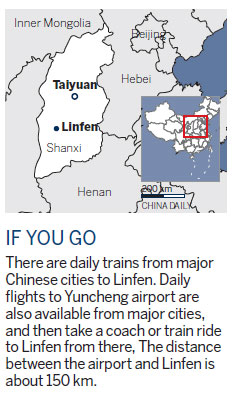
Other ancient Marquis tombs were on display far below the ground. They gave me the chills when I saw them from above.
On my last day in Linfen, I visited the Guangsheng Temple, the Giant Locust Tree and the Yao tomb and temple.
The upper and lower parts of the Guangsheng Temple are separated from each other by mountain roads.
The upper part of the temple features Feihong Pagoda, an octagonal structure with 13 floors made of bricks glazed in yellow and green. It was built roughly 200 years after the lower part of the temple.
I saw different elements of the Ming and Yuan dynasties when comparing the two parts. For example, a Buddha from the Yuan dynasty was made of clay at the lower temple, while those from Ming were made of iron at the upper part.
The highlight of the day was visiting the Giant Locust Tree. I thought it was just a big tree standing alone for people to see, but I couldn't have been more wrong. It is more of a park with a door resembling a tree with grotesque trunks.
The ancient Shanxi people migrated from Linfen to 18 provinces across the country.
Their offspring now total between 200 million to 300 million nationwide, and many people now visit Linfen to trace their ancestors.
The spacious ancestor hall in the garden was filled with more than 1,000 family names carved in wooden tablets neatly arranged on the wall.
Workers there can quickly lead you to your family name. They hinted I should buy some incense and salute my ancestor, but I didn't follow their advice because I thought they were just trying to make money.
I wrapped up my trip after visiting the temple and tomb of Yao, one of the legendary Chinese emperors who lived more than 4,000 years ago, and got a taste of the relics he left behind.
Sun Ruisheng contributed to this story.
Contact the writer at yangfeiyue@chinadaily.com.cn
(China Daily 11/29/2014 page19)
Today's Top News
Chinese consumers' online choices proliferate
CPC sends out inspectors in new round of anti-graft checks
Swiss voters reject gold, immigration proposals
Sarkozy wins French UMP party leadership
Ireland pushes EU drive against smoking
One-child allowances continue with second birth
Editorial: Get HKSAR back on track
Women still outnumbered in top jobs
Hot Topics
Lunar probe , China growth forecasts, Emission rules get tougher, China seen through 'colored lens', International board,
Editor's Picks

|

|

|
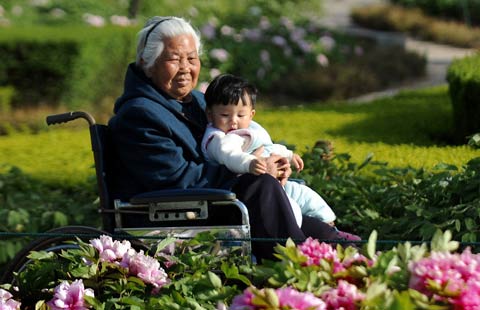
|

|

|
